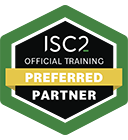category
Certified Secure Software Lifecycle Professional Self-paced (Including Exam Voucher) – Tier 3

Type
Skill Level
Available dates
Learning Path
Virtual
Duration
1 Day

LEARNING PATH
SKILL LEVEL
DURATION
AVAILABLE DATES
Choose date
R27 500,00
Price excluding VAT
Tier 3
Pricing is applicable to the following countries: Algeria, Angola, Botswana, Cameroon, Cape Verde, Cote d’Ivoire, Congo, Djibouti, Egypt, Gabon, Ghana, Lesotho, Libya, Mauritania, Mozambique, Morocco, Namibia, Nigeria, Saint Helena, Ascension and Tristan da Cunha, Senegal, Sudan, Swaziland, Tunisia, Zambia, Zimbabwe.
Introduction
The Certified Secure Software Lifecycle Professional (CSSLP) is a global, vendor-neutral certification to recognize those with leading software and application security skills. The CSSLP recognizes your expertise and ability to incorporate security practices — authentication, authorization and auditing — into each phase of the SDLC.
Audience profile
The CSSLP is ideal for software development and security professionals responsible for applying best practices to each phase of the SDLC – from software design and implementation to testing and deployment – including those in the following positions:
|
|
|
|
|
|
|
|
|
|
|
|
Pre-requisites
The knowledge and skills that a learner must have before attending this course is as follows:
- Candidates must have a minimum of four years of cumulative paid Software Development Lifecycle (SDLC) professional work experience in one or more of the eight domains of the ISC2 CSSLP Common Body of Knowledge (CBK)
- Earning a four-year college degree or regional equivalent in Computer Science, Information Technology (IT) or related fields or an additional credential from the ISC2 approved list will satisfy one year of the required experience
- Education credit will only satisfy one year of experience
- Part-time work and internships may also count towards your experience
- Fulltime Experience: Your work experience is accrued monthly
- Thus, you must have worked a minimum of 35 hours/week for four weeks to accrue one month of work experience
- Part-Time Experience: Your part-time experience cannot be less than 20 hours a week and no more than 34 hours a week
- 1040 hours of part-time = 6 months of full-time experience
- 2080 hours of part-time = 12 months of full-time experience
- Internship: Paid or unpaid internship is acceptable. You will need documentation on company/organisation letterhead confirming your position as an intern. If you are interning at a school, the document can be on the registrar’s stationery
What is included?
- Self-paced online adaptive learning journey
- Data-driven analytics dashboard for real-time feedback on learner progress
- Robust search functionality to narrow topics
- Pre- and post-course assessments
- Knowledge checks and end-of-domain quizzes
- Official ISC2 eTextbook for the certification – Valid for 6 months/180 Days from date of fulfilment
- Single Use ISC2 Certification Exam Voucher – Valid for 12 months/365 Days from date of fulfilment
- Interactive content
- Domain-by-domain study sheets with key points
- Email content support (membersupport@isc2.org/membersupportemea@isc2.org)
- Online interactive flash cards
- Glossary of Terms
- 24/7/365 chat technical support
What is Online Self-Paced Training?
ISC2 Self-Paced Training enables a flexible and engaging learning experience which gives you the freedom and confidence to move ahead on your schedule, without sacrificing quality for convenience. Throughout the entire learning experience, you have on-demand access to interactive learning content and industry topics to reinforce the material and increase your knowledge retention. Course activities which draw from real-world scenarios and a learning Plan helps you stay on track with your studies and help you prepare for your ISC2 certification exam.
How is the Self-Paced Course Accessed?
An access key and instructions will be sent via email after your purchase is complete.
You may then login anytime at https://my.isc2.org/s/login/
Course Objectives
On completion of this program, the participants will be able to:
- Understand and apply the concepts of risk assessment, risk analysis, data classification, and security awareness and Implement risk management and the principles used to support it (Risk avoidance, Risk acceptance, Risk mitigation, Risk transference)
- Apply a comprehensive and rigorous method for describing a current and/or future structure and behaviour for an organisation’s security processes, information security systems, personnel, and organisational sub-units so that these practices and processes align with the organisation’s core goals and strategic direction and address the frameworks and policies, concepts, principles, structures, and standards used to establish criteria for the protection of information assets, as well as to assess the effectiveness of that protection and establish the foundation of a comprehensive and proactive security program to ensure the protection of an organisation’s information assets
- Apply a comprehensive and rigorous method for describing a current and/or future structure and behaviour for an organisation’s security processes, information security systems, personnel, and organisational sub-units so that these practices and processes align with the organisation’s core goals and strategic direction and examine the principles, means, and methods of applying mathematical algorithms and data transformations to information to ensure its integrity, confidentiality, and authenticity
- Understand the structures, transmission methods, transport formats, and security measures used to provide confidentiality, integrity, and availability for transmissions over private and public communications networks and media and identify risks that can be quantitatively and qualitatively measured to support the building of business cases to drive proactive security in the enterprise
- Offer greater visibility into determining who or what may have altered data or system information, potentially affecting the integrity of those asset and match an entity, such as a person or a computer system, with the actions that entity takes against valuable assets, allowing organisations to have a better understanding of the state of their security posture
- Plan for technology development, including risk, and evaluate the system design against mission requirements, and identify where competitive prototyping and other evaluation techniques fit in the process
- Protect and control information processing assets in centralized and distributed environments and execute the daily tasks required to keep security services operating reliably and efficiently
- Understand the Software Development Life Cycle (SDLC) and how to apply security to it and identify which security control(s) are appropriate for the development environment, and assess the effectiveness of software security
| Exam Domains |
| Domain 1: Secure Software Concepts |
| Domain 2: Secure Software Requirements |
| Domain 3: Secure Software Architecture and Design |
| Domain 4: Secure Software Implementation |
| Domain 5: Secure Software Testing |
| Domain 6: Secure Software Lifecycle Management |
| Domain 7: Secure Deployment, Operations, Maintenance |
| Domain 8: Software Supply Chain |
Course Content
| Domain 1: Secure Software Concepts | |
|
|
|
|
| Domain 2: Secure Software Requirements | |
|
|
|
|
|
|
|
|
|
|
| Domain 3: Secure Software Architecture and Design | |
|
|
|
|
|
|
|
|
| Domain 4: Secure Software Implementation | |
|
|
|
|
|
|
|
|
|
|
| Domain 5: Secure Software Testing | |
|
|
|
|
|
|
|
|
| Domain 6: Secure Software Lifecycle Management | |
|
|
|
|
|
|
|
|
|
|
| Domain 7: Secure Software Deployment, Operations, Maintenance | |
|
|
|
|
|
|
|
|
|
|
|
|
|
|
|
|
| Domain 8: Secure Software Supply Chain | |
|
|
|
|
|
|
|
|
Benefits of Certified Secure Software Lifecycle Professional
For the Individual:
- Instant credibility: Proves subject matter expertise in application security and shows desirable skills for employers around the world
- Increased compensation: Can lead to pay gains and “skill premiums”
- Relevant, new knowledge: Expand security knowledge, affirm expertise. Continuing education helps keep skills current and relevant
- Versatile skills: Vendor-neutral so skills can be applied to different technologies and methodologies
- A broader perspective: Holistic understanding of best practices, policies and procedures throughout the software development life cycle; skills to advise others on how to build secure software
- Better protect the organisation: Keep sensitive data safe through secure coding practices
For the Organisation:
- Protect reputation: Reduce loss of revenue and reputation due to a breach resulting from insecure software
- Improve processes: Break the “penetrate and patch” test approach
- Save money: Reduce production cost, vulnerabilities and delivery delays
- Gain instant credibility: Increases credibility of the organisation and its development team.
- Stay current: Ensures professionals are up to date on best practices, policies and procedures through continuing professional education requirements
- Ensure compliance: Comply with government and industry regulations (DoD 8140.01/8570.01 approved)
Associated Certifications and Exam
Associate of ISC2: A candidate who doesn’t have the required experience may become an Associate of ISC2 by successfully passing the CSSLP examination. The Associate of ISC2 will then have five years to earn the four years of cumulative paid Software Development Lifecycle (SDLC) professional work experience in one or more of the eight domains of the ISC2 CSSLP Common Body of Knowledge (CBK).
| Exam Details | Certified Secure Software Lifecycle Professional (CSSLP) |
| Exam Title | CSSLP |
| Number of Questions/Practical Challenges | 125 Questions |
| Test Duration | 3 Hours |
| Test Format | Multiple choice questions |
| Test Delivery | Pearson VUE / Testing Centre |
| Availability | English |
| Passing Score | 700/1000 |

ISC2 Overview
In an increasingly complex cyber world, there is a growing need for information security leaders who possess the breadth and depth of expertise necessary to establish holistic security programs that assure the protection of an organisations information assets.
ISC2 is an international non-profit membership association focused on inspiring a safe and secure cyber world. Today, based in the United States, ISC2 serves its global membership from its headquarters in Alexandria, Virginia, along with a portfolio of credentials and world-class education programs in the form of vendor-neutral education products and career services.
Best known for the acclaimed Certified Information Systems Security Professional (CISSP®) certification, ISC2 offers a portfolio of credentials that are part of a holistic, programmatic approach to security.
ISC2 members, candidates and associates, nearly 675,000 strong, are made up of certified cyber, information, software and infrastructure security professionals who are making a difference and helping to advance the industry. ISC2 members represent an elite, global network of dedicated cybersecurity professionals – preeminent experts in their field – who have committed themselves to the highest ethical standards and best practices. All members are certified professionals who have passed ISC2 examinations attesting to skill and knowledge in their field. Through their ISC2 certification, they have demonstrated superior competency and devoted themselves to making the cyber world a safer place for all.
Torque IT is the longest standing Official Training Partner (OTP) in South Africa and has maintained the status of one of the leading ISC2 accredited training organizations in South Africa. Torque IT remains the Only Preferred OTP in the South Africa. As a leading and established training provider of cybersecurity education and certification, Torque IT is committed to expanding our offerings and promoting cybersecurity awareness and expertise across all ISC2 Certifications and throughout South Africa and various African countries.
